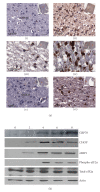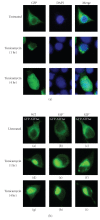Methods for monitoring endoplasmic reticulum stress and the unfolded protein response
- PMID: 20169136
- PMCID: PMC2821749
- DOI: 10.1155/2010/830307
Methods for monitoring endoplasmic reticulum stress and the unfolded protein response
Abstract
The endoplasmic reticulum (ER) is the site of folding of membrane and secreted proteins in the cell. Physiological or pathological processes that disturb protein folding in the endoplasmic reticulum cause ER stress and activate a set of signaling pathways termed the Unfolded Protein Response (UPR). The UPR can promote cellular repair and sustained survival by reducing the load of unfolded proteins through upregulation of chaperones and global attenuation of protein synthesis. Research into ER stress and the UPR continues to grow at a rapid rate as many new investigators are entering the field. There are also many researchers not working directly on ER stress, but who wish to determine whether this response is activated in the system they are studying: thus, it is important to list a standard set of criteria for monitoring UPR in different model systems. Here, we discuss approaches that can be used by researchers to plan and interpret experiments aimed at evaluating whether the UPR and related processes are activated. We would like to emphasize that no individual assay is guaranteed to be the most appropriate one in every situation and strongly recommend the use of multiple assays to verify UPR activation.
Figures




References
-
- Ron D, Walter P. Signal integration in the endoplasmic reticulum unfolded protein response. Nature Reviews Molecular Cell Biology. 2007;8(7):519–529. - PubMed
-
- Schroder M, Kaufman RJ. The mammalian unfolded protein response. Annual Review of Biochemistry. 2005;74:739–789. - PubMed
-
- Oikawa D, Kimata Y, Kohno K. Self-association and BiP dissociation are not sufficient for activation of the ER stress sensor Ire1. Journal of Cell Science. 2007;120(9):1681–1688. - PubMed
LinkOut - more resources
Full Text Sources
Other Literature Sources

